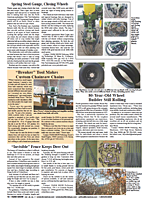You have reached your limit of 3 free stories. A story preview is shown instead.
To view more stories
(If your subscription is current,
click here to Login or Register.)
Bee Balm Can Be Useful In Gardens
Bee balm, a popular native of eastern North America, goes by many names. You might know this shaggy scarlet flower as wild bergamot, monarda or Oswego tea. Itís an attractive ornamental that thrives in zones 4 through 9. As a cottage garden favorite, bee balm holds appeal even when not in bloom, making it ideal for per
..........
You must sign in, subscribe or renew to see the page.

You must sign in, subscribe or renew to see the flip-book
Bee Balm Can Be Useful In Gardens
Bee balm, a popular native of eastern North America, goes by many names. You might know this shaggy scarlet flower as wild bergamot, monarda or Oswego tea. Itís an attractive ornamental that thrives in zones 4 through 9. As a cottage garden favorite, bee balm holds appeal even when not in bloom, making it ideal for perennial borders and backdrops.
The flowers are filled with nectar, making them a favorite food source of ruby-throated hummingbirds and butterflies. But lucky for gardeners, deer and rabbits tend to leave it alone. Still, the flowers are both edible and highly nutritious. Eat them fresh or dried for a good supply of protein and antioxidants.
Bee balm leaves contain an antiseptic thatís useful for skin irritations as well as mouth, gum or tooth infections. During the American Revolution, colonists used it as a substitute for English black tea. As the common name implies, it was once used as a treatment for bee stings. In contrast, the flower has little in common with the bergamot orange (used for Earl Grey tea) besides its scent.
While bee balm can be planted in the spring or fall, itís best to trim back the foliage for fall plantings to encourage root growth. The plant prefers full sun, but partial shade in the afternoon is also suitable. Too much shade will make it grow leggy. Ensure thereís rich soil amended with compost, and add mulch to keep moisture levels appropriate.
As a member of the mint family, bee balm requires careful planning for its planting location. Otherwise, youíll deal with spread. In southern regions, itís even regarded as aggressive.†The plant can reach up to 4 ft. with a spread of 3 to 4 ft., though dwarf varieties top out at 15 in. The tallest plants might require staking, but most have sturdy enough stems to be fine.
Once established, bee balm requires minimal maintenance. Deadhead spent flowers to encourage a full season of blooms, but leave a few as fall approaches; the seeds offer a much-appreciated winter food supply for birds.
To read the rest of this story, download this issue below or click
here to register with your account number.





